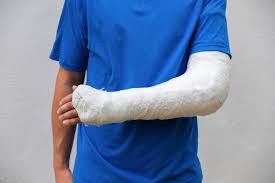Fracture clinic in Lokapur

Fractures
Closed vs. Open Fractures:
Closed Fracture:
- The skin over the fracture site remains intact.
- Risk of infection is minimal.
- Swelling, bruising, and deformity may be present.
Open Fracture:
- The broken bone punctures the skin or is exposed through a wound.
- High risk of infection (osteomyelitis).
- Requires urgent medical attention to clean and stabilize the fracture.
Dislocations of Joints:
- Dislocation involves the displacement of bones in a joint, disrupting normal alignment.
- Symptoms include visible deformity, severe pain, swelling, and loss of function.
- Common sites: shoulder, elbow, hip, and finger joints.
Diagnosis Protocol for Fractures and Dislocations
Initial Assessment:
- History: Mechanism of injury, timing, and previous injuries.
- Physical Examination:
- Inspect for deformity, swelling, and wounds.
- Palpate for tenderness and abnormal movements.
- Assess neurovascular status (pulses, capillary refill, sensation, and motor function).
Imaging Modalities:
- X-ray: Standard first-line investigation; two views (AP and lateral).
- CT Scan: For complex fractures or suspected bone involvement not clear on X-rays.
- MRI: Ideal for soft tissue injuries and ligament involvement.
- Ultrasound: Useful for pediatric cases or soft tissue evaluation.
First Aid and Emergency Management
Initial Steps:
- Avoid moving the injured part unnecessarily.
- Check and manage bleeding with sterile dressings.
- Assess for shock and maintain vital functions.
Stabilization:
- Immobilize the fracture using splints or slings.
- Ensure the joint above and below the fracture is supported.
- Avoid attempting to realign the bones or reduce dislocations without expertise.
Transportation:
- Use a stretcher for safe patient transfer.
- Maintain immobilization during transport to prevent further injury.
Treatment Modalities
Non-Surgical Interventions:
- Closed Reduction: Realignment of bone fragments or dislocations manually.
- Immobilization: Using casts, splints, or braces to maintain position.
- Traction: Gradual pulling force for realignment in specific fractures.
Surgical Interventions:
- Open Reduction and Internal Fixation (ORIF):
- Fixation using plates, screws, or intramedullary nails.
- Common for complex fractures or displaced joints.
- External Fixation:
- Stabilization using external frames.
- Often used for open fractures or when soft tissue healing is a concern.
- Arthroscopy:
- Minimally invasive technique for joint injuries.
- Joint Replacement:
- For severe joint damage, such as irreparable hip or shoulder dislocations.
This framework ensures a comprehensive approach to managing fractures and dislocations while prioritizing patient safety and recovery.